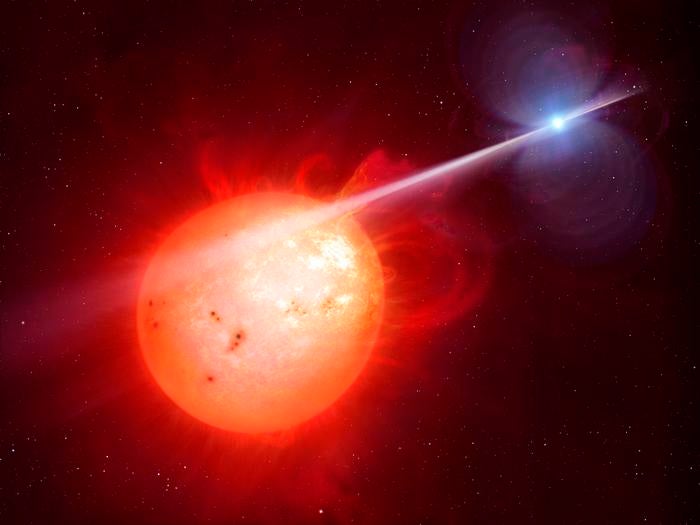
Astronomers have captured their second-ever glimpse into a rare celestial object: a white dwarf pulsar.
Pulsars are typically envisioned as spinning neutron stars — a type of stellar remnant left by only massive stars. Despite white dwarfs being the most common stellar fossils, created by Sun-like and smaller stars, pulsar emission has only been observed once before from a white dwarf. The find may illuminate aspects of star formation, their evolution, and how these objects generate their strong magnetic fields. Details on the find were published this month in Nature Astronomy.
The new find
The pulsar consists of a white dwarf in a binary system that blasts its neighboring red dwarf with mighty beams of particles and electromagnetic radiation. Dubbed J191213.72-441045.1, or J1912-4410 for short, the white dwarf pulsar spins 300 times faster than Earth, or about once every five minutes. And despite being a similar size to our home planet, the white dwarf has a mass as large as the Sun.
A white dwarf is born after a Sun-like star exhausts its fuel, leaving behind its hot core with a temperature of some 180,000 degrees Fahrenheit (100,000 degrees Celsius). The new white dwarf will then begin to cool and spin more slowly — unless it’s accumulating nearby matter. That’s because pulling material off a companion can keep the white dwarf rotating more quickly instead of slowing down.
“Due to their old age, the white dwarfs in the pulsar system should be cool. Their companions should be close enough that the gravitational pull of the white dwarf was in the past strong enough to capture mass from the companion, and this causes them to be fast spinning,” said Ingrid Pelisoli, a binary evolution expert at the University of Warwick and a study author, in a statement. “All of those predictions hold for the new pulsar found.”
J1912-4410 has already cooled to about 23,000 F (12,800 C), indicating it is old, but its period of five minutes is relatively fast. All that fits perfectly with the picture astronomers have of a white dwarf pulsar system.
Although astronomers know the white dwarf’s magnetic field powers the pulses, they are still investigating the exact driving mechanism. In neutron star pulsars, no companion star is required. But in white dwarf pulsars, researchers think the beams of energy from the spinning white dwarf accelerate electrons in the atmosphere of the neighboring red dwarf to close to the speed of light.
The team spotted the brightening associated with this phenomenon while searching for white dwarf pulsars. They used a camera dubbed ULTRACAM on the 3.58-meter New Technology Telescope in La Silla, Chile, which is capable of taking 500 pictures a second to detect rapid changes in light.
AR Scorpii: A previous discovery
J1912-4410 follows in the footsteps of the first white dwarf pulsar, discovered in in 2016. The star system, AR Scorpii, is located 380 light-years away in the constellation Scorpius. The pulsar has a period of 1.97 minutes over a broad range of wavelengths, including radio and X-rays. Before this discovery, astronomers had theorized white dwarf pulsars could exist, but had fruitlessly searched for them for more than five decades.
All other known pulsars are neutron stars that rotate rapidly, some thousands of times per second. Their strong magnetic fields create focused beams released from their poles as they whirl, sending out radio waves and high-energy electromagnetic radiation.
But what causes the strong magnetic fields in a white dwarf remains unknown. The team suspects that the white dwarf’s core may harbor a dynamo — the same mechanism that powers Earth’s magnetic field. As the white dwarf “spins up” by accreting matter, the dynamo effect is intensified, leading to a magnetic field strong enough to cause the pulsar effect we see.
“The origin of magnetic fields is a big open question in many fields of astronomy, and this is particularly true for white dwarf stars. The magnetic fields in white dwarfs can be more than a million times stronger than the magnetic field of the Sun, and the dynamo model helps to explain why. The discovery of J1912−4410 provided a critical step forward in this field,” Pelisoli said. With two examples now instead of one, researchers can learn more about these objects and build better models to describe them, even as they continue searching for more.









